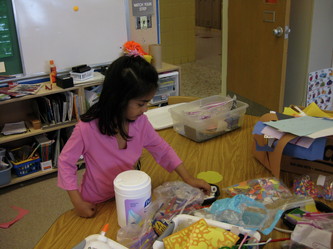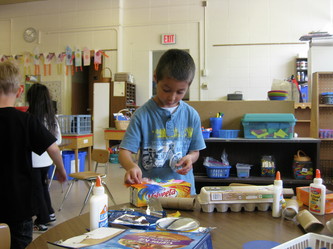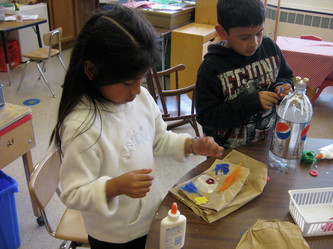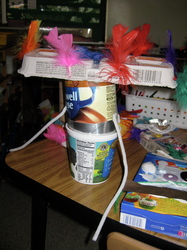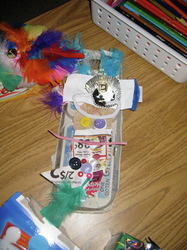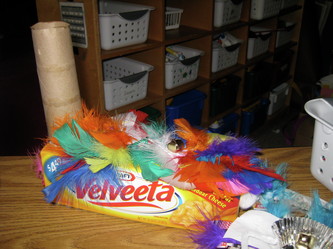Reduce, Reuse, Recycle
Recycled Art Animals
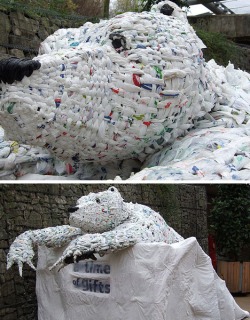
Toward the end of the unit, students participated in a lesson dedicated to creating Recycled Art Animals. For several weeks, the students and I collected recycled items from home and school recycling bins. We saved things like paper, water bottles, plastic bags, soup cans, cereal and cracker boxes, oatmeal tubs, soda cans, and sour cream containers. We used these materials, along with the classroom craft bucket, to create Recycled Art Animals. The students were currently studying the physical attributes, and needs of animals in their Science curriculum.
To begin the lesson, I read students the book Dumpster Diver by Janet S. Wong, which tells the story of a group of friends who use recycled materials to make new things. Next, we brainstormed a list of body parts that an animal might have such as: eyes, nose, mouth, ears, hair/fur, legs, arms, hands, feet, body, toes, tail, claws, etc.
Following our brainstorm, students searched through the materials and selected recycled items to form their animals. I placed craft materials such as: glue, tape, yarn, buttons, scrap paper, beads, pipe cleaners, styrofoam balls, feathers, and cotton balls amongst other items, for students to use in their construction. Students were given 20-30 minutes to piece together their animal, and decorate it.
Detailed in the lesson plan are procedures for the Gallery Walk I intended on leading with students the next day, as a way to share our recycled animals.
Take a look at the photo gallery below from our Recycled Art Animal construction day, click to enlarge photos and read captions!
Photo Credit (Above): Weburbanist.com, 2010
To begin the lesson, I read students the book Dumpster Diver by Janet S. Wong, which tells the story of a group of friends who use recycled materials to make new things. Next, we brainstormed a list of body parts that an animal might have such as: eyes, nose, mouth, ears, hair/fur, legs, arms, hands, feet, body, toes, tail, claws, etc.
Following our brainstorm, students searched through the materials and selected recycled items to form their animals. I placed craft materials such as: glue, tape, yarn, buttons, scrap paper, beads, pipe cleaners, styrofoam balls, feathers, and cotton balls amongst other items, for students to use in their construction. Students were given 20-30 minutes to piece together their animal, and decorate it.
Detailed in the lesson plan are procedures for the Gallery Walk I intended on leading with students the next day, as a way to share our recycled animals.
Take a look at the photo gallery below from our Recycled Art Animal construction day, click to enlarge photos and read captions!
Photo Credit (Above): Weburbanist.com, 2010
Time Needed: Two, 40 minute periods
Essential Questions:
- What are each of the three R's (Reduce, Reuse, Recycle), and what do they look like in practice?
- How can we adjust our habits to help the Earth?
Objectives:
I. Affective
· SWBAT comfortably participate throughout the entirety of the lesson.
· SWBAT express their creativity in an art project.
· SWBAT respect the artwork of their peers.
II. Cognitive
· SWBAT contribute to a class list of animal attributes.
· SWBAT create an artistic animal comprised of recycled materials.
· SWBAT describe each of the pieces of their animal in relation to their original use, and new animal attribute.
· SWBAT pose questions in relation to peer artwork.
Materials Needed:
- Dumpster Diver by Janet S. Wong
- Chart paper and markers
- Projector
- Computer
- Powerpoint with photographs of recycled art
- Collected recyclables (cereal and cracker boxes, toilet paper tubes, sour cream tubs, oatmeal container, etc.)
- Craft materials (glue, tape, cotton balls, pipe cleaners, beads, buttons, yarn, cellophane, etc.)
- Notecards with visual and written prompting for questions
I'll begin the lesson with a reading of Dumpster Diver by Janet S. Wong. I'll ask students which of the three R's the book corresponds to, guiding them to recognize that it addresses all three: Reduce (instead of creating new, re-purposing an object we already possess), Reuse (finding a new use for an old object), and Recycle (using recyclables). Procedures:
1) Next, I'll reference the animals students have been learning about during their Science block, like the guppies and snails they've been observing for the past few weeks. Each student will contribute to a list of attributes an animal might have: tail, nose, mouth, eyes, ears, hair/fur, feet, hands, arms, legs, claws, feathers, beak, etc.
2) Using a projector and computer, I'll show students a short slideshow of various recycled art pieces. Including a polar bear comprised of plastic shopping bags.
3) Students will work alongside their writing/reading groups at their assigned tables. I will circulate the room with recyclable objects, allowing the students to select 2-3 objects to use as the big pieces in their art piece.
4) Students will have the remaining class period to construct their recycled animals.
5) Following day: The next day, once students' creations have dried, they'll share these in a gallery walk, much like an art show. Students will be numbered 1-4, 1s will present first, other students will travel with their numbered group. Groups will present in succession. During each presentation every student will have an assigned question to ask:
a. Tell us about your animal – What kind of animal is it? What body parts does it have?
b. Tell us about what materials you used – What materials did you use to make your animal?
c. Tell us about how you reused items to create your animal – What was each piece before you used it as a part of your animal?
These questions will be given to students on notecards, with both a visual representation of the question they are responsible for asking, as well as a few keywords. Before the gallery walk begins, students will practice these questions as a whole group while interviewing me about my own recycled art animal.
Presentation Progression:
1s Present – approx. 2-3 min. per presenter
1a – to 2s
1b – to 3s
1c – to 4s
(rotate to each of the presenters)
2s Present
2a – to 1s
2b – to 3s
2c – to 4s
(rotate to each of the presenters)
3s Present
3a – to 2s
3b – to 4s
3c – to 1s
(rotate to each of the presenters)
4s Present
4a – to 3s
4b – to 2s
4c – to 1s
(rotate to each of the presenters)
Assessment:
Assessment for this lesson will occur during the gallery walk on the second day. I'll be listening in to each of the students' descriptions of their animals, materials, and understanding of reused items. I'll also be attentive to students' abilities to pose questions to their peers and hold a discussion with positive feedback.
- Described recycled animal with a name and body parts.
- Listed materials used in creation of animal.
- Demonstrated knowledge of prior function, and current use. (i.e., "This was a plastic water bottle, but I used it as the body for my hippopotamus")
Special Considerations:
Depending upon students' attention levels, I might choose to break apart the second half of the lesson across two, 20-minute intervals, throughout the day. I want to ensure that each student has a chance to share their animal, while still engaging students.
| lesson_4-recycled_art_animals.doc |
